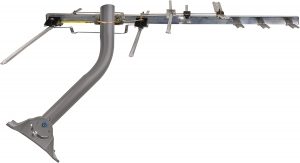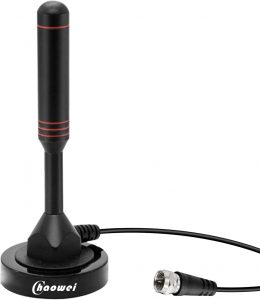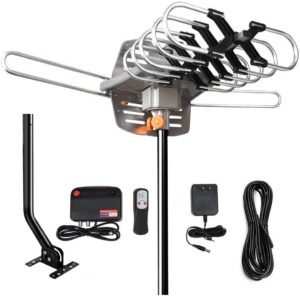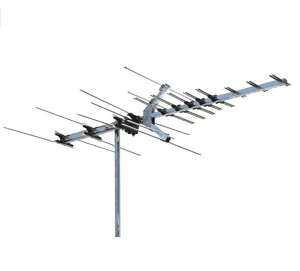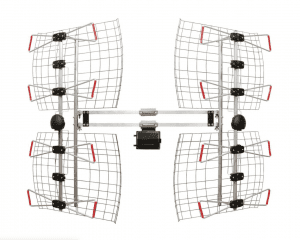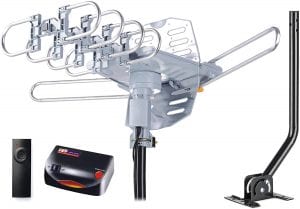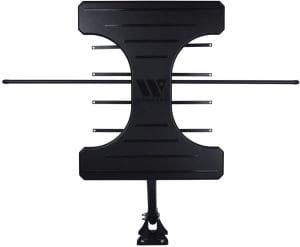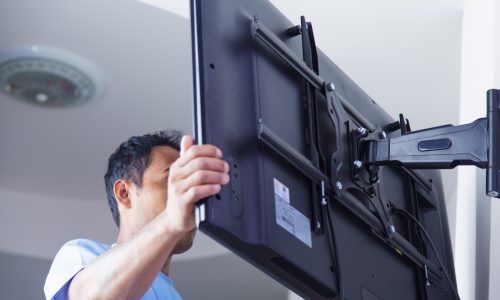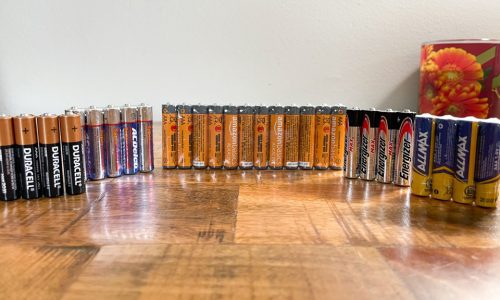Get The Best Outdoor Antenna To Make Watching TV A Breeze
We looked at the top 16 Outdoor Antennas and dug through the reviews from 20 of the most popular review sites including and more. The result is a ranking of the best Outdoor Antennas.

Our Review Process
Don't Waste Your Money is focused on helping you make the best purchasing decision. Our team of experts spends hundreds of hours analyzing, testing, and researching products so you don't have to. Learn more.
Our Picks For The Top Outdoor Antennas
- 1. RCA Outdoor Yagi UHF/VHF Satellite HD Antenna, 70-Mile Range
- 2. Chaowei Compact Waterproof Outdoor Antenna, 40-Mile Range
- 3. McDuory Low Noise Amplifier Outdoor Antenna, 150-Mile Range
- 4. BEFORE Low Noise Amplifier Rural Outdoor Antenna, 150-Mile Range
- 5. 1 BY ONE Television Signal Boosting Outdoor Antenna, 100-Mile Range
- 6. Winegard HD7694P Digital TV Signals Mounted Outdoor Antenna, 45-Mile Range
- 7. Channel Master Steathtenna CM-3010HD Easy Install Outdoor Antenna, 50-Mile Range
- 8. Antennas Direct DB8e 8-Element Bowtie Attic/Outdoor HDTV Antenna, 70-Mile Range
- 9. Antennas Direct Clearstream Satellite Indoor/Outdoor Antenna, 70-Mile Range
- 10. Winegard HD8200A Free TV Programming Indoor/Outdoor Antenna, 65-Mile Range
- 11. Five Star Outdoor Motorized High Image Resolution Antenna, 200-Mile Range
- 12. MATIS Outdoor High Performance Antenna, 150-Mile Range
- 13. PBD WA-2608 Low Noise Outdoor HD TV Antenna, 150-Mile Range
- 14. Antennas Direct Yagi Broadcast UHF DTV Outdoor Antenna, 70-Mile Range
- 15. Antennas Direct Clearstream Reflective Outdoor TV Antenna, 70-Mile Range
- 16. Winegard Elite Outdoor Optimized Dual-Band Antenna, 70-Mile Range
You get high-quality picture and sound to enjoy top-rated network programming with this outdoor antenna. It receives 4K, 8K and 1080 HDTV. The antenna is easy to install and comes pre-assembled.
High-Quality Picture and SoundThis long-range antenna enables you to enjoy top-rated network programming.
You'll enjoy 360-degree reception within a 40 mile radius when you go with this outdoor antenna. It's compact in size, waterproof and outfitted with a magnetic base. The device allows for free access of a wide range of channels, eliminating the need to pay for cable.
Budget-Friendly PickAlthough this outdoor antenna has an affordable price tag, quality isn't compromised.
This outdoor antenna supports not one, but two televisions. It has a long range of 150 miles and can rotate a full 360 degrees. What users will love the most is the included set of remotes that operate using infrared technology.
Easy to InstallYou won't need any tools to install this outdoor antenna.
This popular outdoor antenna has a long 150-mile range with a 360-degree rotation. It allows for viewing live television in high definition without a separate cable subscription. The device supports two televisions, although you can purchase a splitter separately to accommodate additional units.
Everything You NeedIf you'd rather keep this outdoor antenna indoors, you can install it in your attic.
Buying Guide
Whether you want to watch the local news, see your favorite sports team or check out the new series everyone’s talking about, you can access more channels on your TV with an outdoor antenna. Regardless of where you live in the country, it’s likely that you can access local TV broadcasts from your home. In fact, over 99 percent of households in the United States can access at least one local TV channel. Plus, 89 percent of households can access at least five stations.
If you have a high-quality outdoor antenna, you can access excellent picture quality over-the-air signals. In some cases, the picture quality may even outperform cable and satellite providers because they usually have to use data compression, which can compromise quality.
There are number of different types of outdoor antennas you can use. Keep in mind that indoor antennas are not made to be used outdoors. These are designed specifically to hook up with your TV, and are not designed to withstand the outdoor elements. Outdoor antennas, on the other hand, are designed to attach to your roof or be placed in your attic. They are typically larger than indoor antennas as a larger surface area is needed to receive more channels. Most outdoor antennas have HD TV quality.
If you live in a rural area, opt for an amplified outdoor antenna. This is a way to improve reception of the TV signals, which may be weak in your area. The amplifier can be built into the outdoor antenna or it can be attached as a separate device which helps boost the signal. Keep in mind that one of the disadvantages of an amplified outdoor antenna is that it can also negatively affect reception by overamplifying the noise.
Some outdoor antennas are single direction, which means that they are designed to only receive signals from one physical direction. Others are multi-direction, so they can receive signals coming from several different areas. One step beyond a multi-direction antenna is an omni-directional antenna. This type of antenna is able to pick up more signals than a multi-direction antenna. However, there are drawbacks to multi-direction and omni-direction antennas, as they can also pick up interference. This can result in distorted picture quality.
Why we recommend these outdoor antennas?
Products Considered
Products Analyzed
Expert Reviews Included
User Opinions Analyzed
Our experts reviewed the top 16 Outdoor Antennas and also dug through the reviews from 20 of the most popular review sites including and more. The result is a ranking of the best of the best Outdoor Antennas.
DWYM is your trusted roduct review source. Our team reviews thousands of product reviews from the trusted top experts and combines them into one easy-to-understand score. Learn more.
The Best Bang For Your Buck
Chaowei Compact Waterproof Outdoor Antenna, 40-Mile Range
Key Takeawy
You'll enjoy 360-degree reception within a 40 mile radius when you go with this outdoor antenna. It's compact in size, waterproof and outfitted with a magnetic base. The device allows for free access of a wide range of channels, eliminating the need to pay for cable.
What to Look For
- When you’re looking for an outdoor antenna, one of the most important things to think about before you get started is which channels are actually available over the air where you live. You can search for topographical maps of your area and the related TV signals online to get an idea of which channels will be available to you where you live.
- Out of the channels you have available, determine whether any of them are of interest to you. You can check TV guides online for those specific channels to see what kinds of programs air on them and whether those are what you want to watch on TV.
- Ensure that you can legally put up an antenna outside. In most cases, you should be allowed to, but it may be a concern in rentals or condominium-style homes.
- Keep in mind that you also have to connect your outdoor antenna to your TV inside, which can be challenging in some homes. In order to connect them, you have to use a high-quality coaxial cable. This kind of cable has a wire in the center that carries the TV signal, plus an outer braid of wires which protect the inner cable from interference. You will have to carefully measure the distance from the antenna to the TV and determine the right placement to run the coaxial cable. If you are connecting multiple shorter coaxial cables together, the signal will be compromised slightly every time you add on another cable. Ideally, it’s best to find the shortest distance between the outdoor antenna and the TV.
- It’s hard to know how your outdoor antenna will work until you actually have it mounted and connected. In some areas, especially where there are hills or tall buildings, the TV signals can bounce off obstacles and result in interference. You may have to play with the placement and angle of the outdoor antenna to ensure you get the best reception possible.
More to Explore
Today, you have the option to choose from dozens – sometimes hundreds – of television channels that are available over the air through outdoor antennas. Here are some fun facts about TV antennas you may not know.
- Over-the-air TV channels are completely free. All you have to pay for is the cost of the outdoor antenna and the cables needed to connect it with the TV. Other than that, there are no monthly costs as there are with cable and satellite TV.
- If you live in a rural area, you may not have access to a high-definition broadcast. It’s always best to check which TV channels are available over the air where you live before you buy an outdoor antenna.
- An HDTV antenna actually provides a superior quality picture to satellite and cable. Many people assume cable TV is of higher quality, but that picture is compressed and lower quality to over-the-air signals.
- If you don’t see any signal on a certain TV channel, you may want to check the sub-channels. A TV station can broadcast on both channels (like channel 8) and subchannels (like 8.1, 8.2 and so on).

